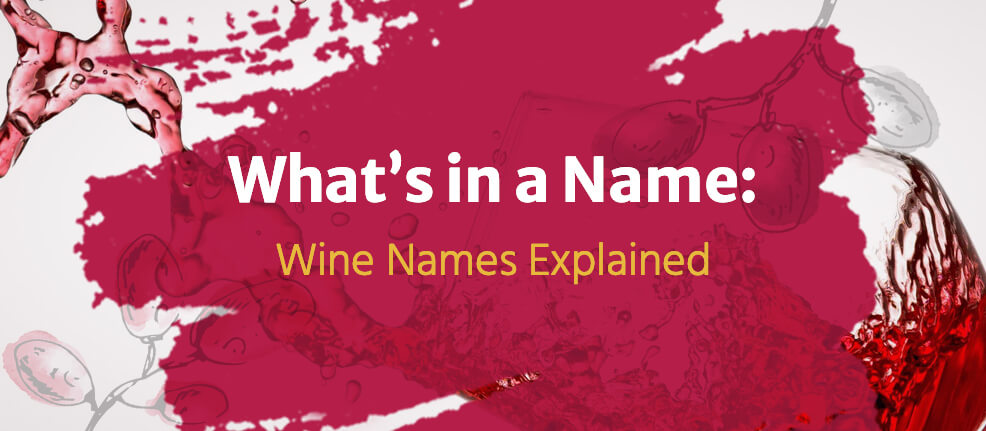
France, Italy, Spain, the U.S. and Argentina fill out the top five spots for worldwide wine production. Argentina produces 5.38% of the world’s wines, while France tops the list at 16.54%. We can’t deny wine’s popularity around the world. Yet, few stop to ask about how gets wine its name before pouring a glass.
Have you stopped to think about the history of the wine you enjoy? Have you ever wondered why ice wine is called ice wine? How about how sherry earned its name? Pour yourself a glass of your favorite varietal and discover how wines are named — plus more interesting information — below.
Understanding Wine Name Basics
Before delving into the topic of wine names, understand two key points. Most wine names tie to the region where they’re crafted or the grapes used during their production. While there are exceptions to the rule, most wineries stick to these principles.
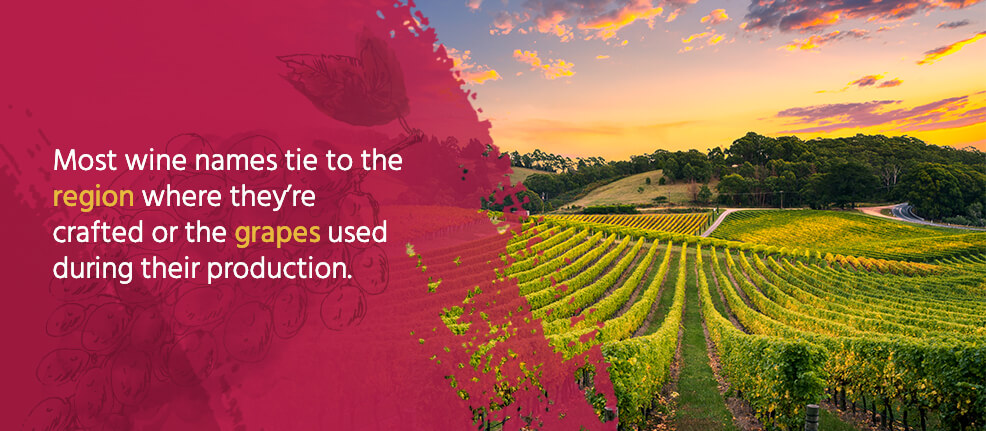
Wines from countries with a long history of producing wines and strict regulations earn the title “Old World”. France, Germany, Italy, Portugal and Spain serve as examples of countries producing Old World wines. Traditionally, the region dictates the different names of winesmade in these countries.
Countries with less of a history in winemaking produce “New World” wines. Wines falling in this category come from places like Australia, Chile, South Africa and the U.S., but different wine names typically come from the type of grape used.
Exceptions with wine names occur from time to time. Some winemakers skip traditions and create names specific to their winery. Others use creativity to come up with names for their blends. As an example, Michael David Winery in California turned to creativity to draw attention to its wines, with The 7 Deadly Zins Zinfandel. In its first decade after the name change, sales grew to 250,000 cases per year.
Wines Named for Their Region
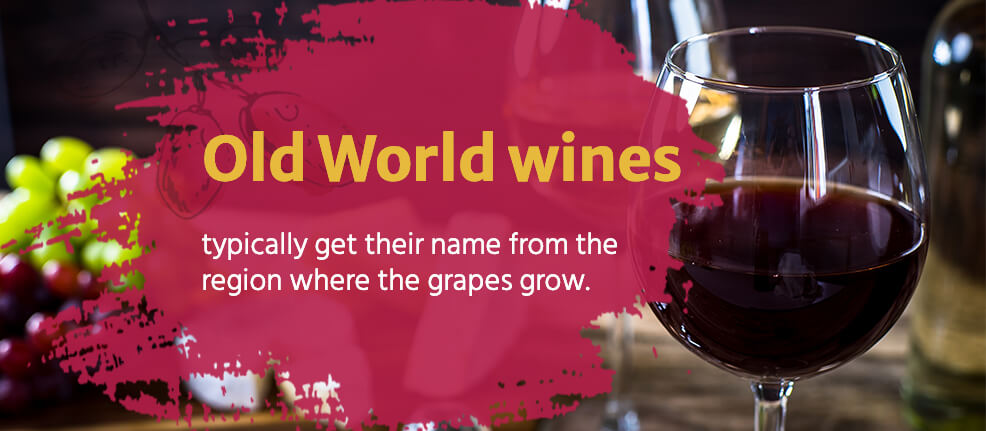
Just as there are hundreds of grape varieties, regions producing wines also create an extensive list. We’ve narrowed our list to some of the more popular regions and wine names.
Italian and Sicilian Wines
Wine has been a part of Italy’s history for centuries. Vineyards sprawl the countrysides, creating the connections between these wines and the regions they come from:
- Amarone – Veneto
- Arneis – Piedmont
- Asti Spumante – Piedmont
- Barbaresco – Piedmont
- Barbera – Veneto
- Bardolino – Veneto
- Barolo – Piedmont
- Brunello di Montalcino – Tuscany
- Chianti – Tuscany
- Lambrusco – Northern Italy
- Marsala – Sicily
- Valpolicella – Veneto
- Vino Nobile di Montepulciano – Tuscany
French Wines
France and wine seem to go hand in hand. With the country’s wine history spanning over 2,500 years, it’s no wonder we know these wines — and possibly their regions of origin — so well:
- Beaujolais – Eastern France
- Bordeaux – Bordeaux region
- Burgundy – Burgundy
- Chablis – Burgundy
- Champagne – Champagne
- Chateauneuf-du-Pape – Rhone Valley
- Chinon – Loire Valley
- Condrieu – Rhone Valley
- Cotes du Rhone – Rhone Valley
- Pouilly-Fuisse – Burgundy
- Pouilly Fume – Loire Valley
- Rhone – Rhone
- Sancerre – Loire Valley
- Sauternes – Sauternes
- Vouvray – Loire Valley
Spanish and Portuguese Wines
Don’t forget these European countries that create an array of delicious wines and have done so throughout history. Spanish and Portuguese wines and their regions include:
- Port – Douro Region, Portugal
- Ribera del Duero – Ribera del Duero, Spain
- Rioja – Rioja, Spain
- Sherry – Jerez de la Frontera, Spain
Wines named for regions can be confusing to buyers. Take Champagne as an example. Many people mistakenly believe that Champagne earns its name for the variety of small grapes. In fact, Black Corinth grapes, aka Champagne grapes, come from Greece and these grapes do not go into the famous bubbly wine, but are sold as dried currants. Champagne actually contains three varieties of grapes: Chardonnay, Meunier and Pinot Noir.
Identifying Wines by Region
Wines named for regions can be confusing to buyers. Take Champagne as an example. Many people mistakenly believe Champagne earns its name for the variety of small grapes. In fact, black corinth grapes, aka Champagne grapes, come from Greece, and they do not go into the famous bubbly wine but are sold as dried currants. Champagne actually contains three varieties of grapes — chardonnay, meunier and pinot noir.
Seven items form the basis of any Old World wine label:
- Producer of the wine
- Production year for the wine
- Region and subregion
- “Bottled at the Estate” terminology
- Alcohol by volume
- Address of the winery
- Volume within the bottle
Old World wines rarely list the exact style of wine. It’s assumed the buyer understands the different types of wines coming out of each region. Understanding the regions can help customers shop for Old World wines.
Wines Named After Grape Varieties
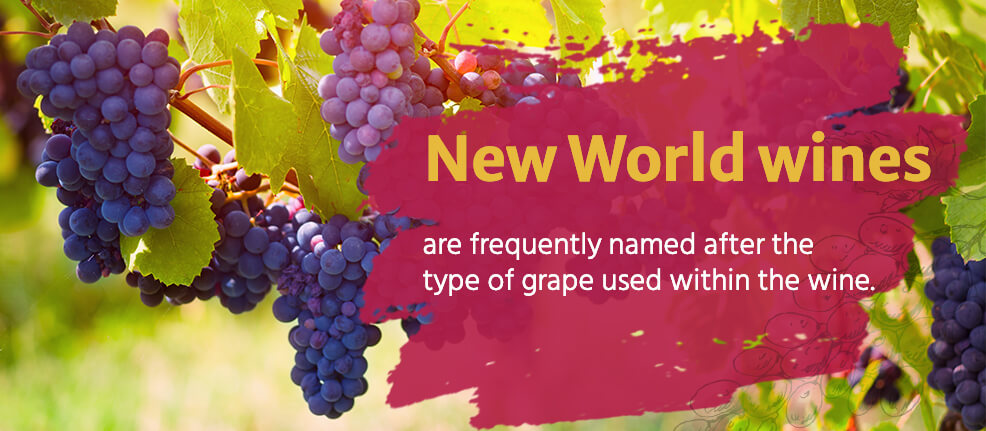
New World wines are frequently named after the type of grape used within the wine. While thousands of grape varieties exist in the world today, Wine Spectator says approximately 1,300 grape varieties make their way into commercial wines. Of those, only 21 grape varieties regularly appear as types of wine names.
Grapes Typically Used in Red Wines
If you’re wondering how are wines named, these red wines described for their grapes offer a simple answer:
- Cabernet franc: A parent to cabernet sauvignon grapes, cabernet franc stands out as it ripens earlier. It’s used commonly in blends.
- Concord: Popular in jellies and grape juice, concord grapes also make impressive wines. Concord, Massachusetts, earns praise for being the birthplace of the grapes within the U.S. This grape variety ripens early and produces juice with a deep purple color.
- Cabernet sauvignon: Scientists proved through DNA analysis that cabernet sauvignon is a cross between cabernet franc and sauvignon blanc. It became the most popular grape variety in the world in 2010.
- Grenache: Spain’s garnacha grapes go into some of the world’s best wines. Their popularity stems from the flavors these grapes impart into the wines they create. It’s common for grenache to bring berries and spices to mind.
- Malbec: Malbec grapes originated in France. Traditionally used to create Bordeaux wines, the grape does produce an intriguing wine on its own. It’s not as common due to the vine’s proclivity to root rot.
- Merlot:Merlot grapes came from Bordeaux, France. Once used in blends, merlots gained a following as a varietal wine.
- Pinot noir: History ties pinot noir grapes to the Ancient Romans. It’s a harder grape to grow, as it is particular about the climate. The wines it produces, however, make the efforts worthwhile.
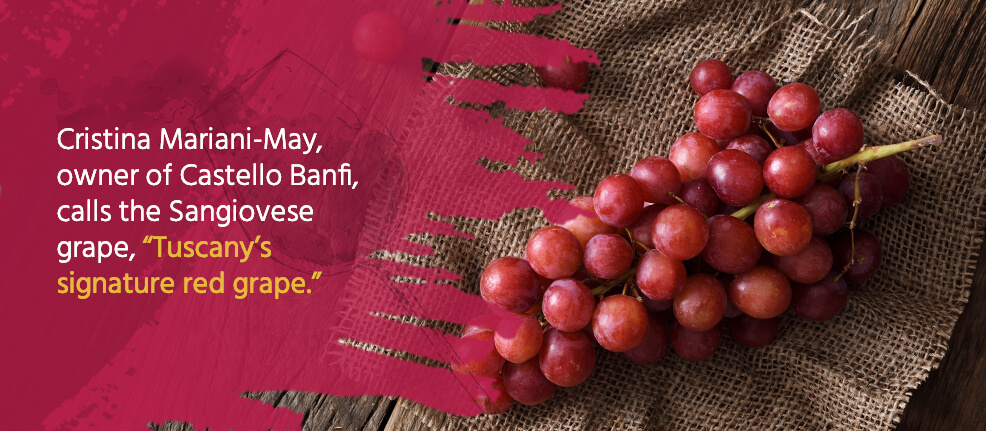
- Sangiovese: Cristina Mariani-May, owner of Castello Banfi, calls the sangiovese grape, “Tuscany’s signature red grape.” It’s a temperamental grape that produces exceptional red wines. Strict Italian rules also often restrict it from being part of a blend.
- Shiraz or syrah: Scientists tested the DNA of syrah grapes and found they’re a cross between dureza and an unknown variety of white grapes. Depending on the region, this grape’s also referred to as syrahor shiraz. It’s used in dry red wines.
- Tempranillo: Originating in Spain, tempranillo grapes predominately serve as a key ingredient in Spain’s red Rioja. The grapes ripen early and have their own holiday on Nov. 8.
- Zinfandel:Zinfandel grapes share very similar DNA to Italian primitivo grapes. More research found zinfandel grapes’ DNA matches Croatian crljenak kastelanski grapes. Despite the connection to primitivo, U.S. laws require zinfandel wines to be called zinfandels and never primitivo.
Grapes Typically Used in White Wines
If you’re more of a white wine drinker, these possibly familiar varietals also take the name from their grape:
- Chardonnay: Chardonnay grapes reached California in the 1800s, but Prohibition led to the destruction of most plants. Some survived, and the grape grew popular in the 1970s. This grape crosses the gouais blanc and pinot noir.
- Gewürztraminer: Gewürztraminer grapes gained the name from the German word gewürz, meaning spicy. The grapes do have a distinctly spicy scent. Gewürztraminer grapes contain high sugar contents and produce high-alcohol wine.
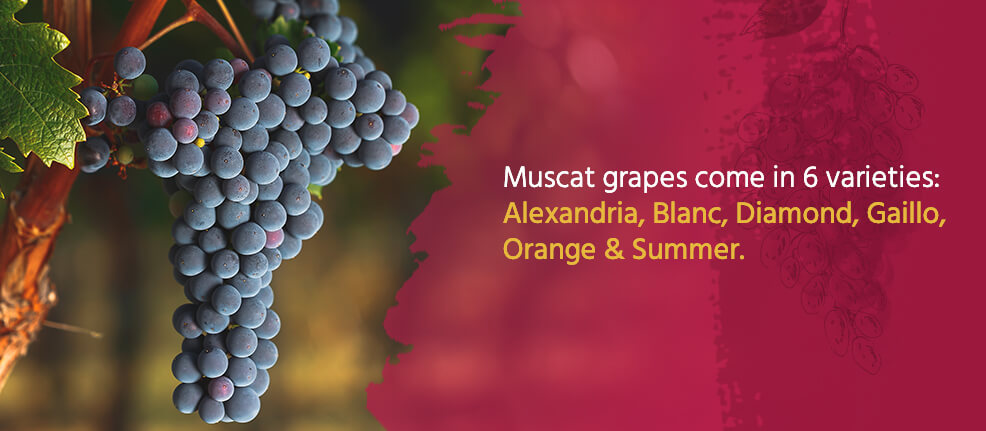
- Moscato or muscat:Muscat grapes come in six varieties — Alexandria, blanc, diamond, gaillo, orange and summer. This versatility helps winemakers produce everything from sparkling wines to dessert wines.
- Niagara: Niagara grapes frequently make their way into white grape juice. They’re gaining popularity for winemaking due to their high yields. The grapes originated in Niagara County, New York, where a cross of cassady and concord grapes led to their creation.
- Pinot blanc: Pinot blanc grapes often carry more sweetness than acidity. As a result, wines made with this grape don’t improve with age. Still, it’s a solid choice for someone looking for an easy-to-drink wine.
- Pinot grigio: Similar to pinot gris grapes, pinot grigio grapes grow best in a cool climate. They result in a dry yet refreshing wine.
- Pinot gris: Pinot meaning “pine” pairs with gris meaning “grey” to form the name of these grapes. Pinot grisgrape clusters resemble pinecones. The skin on the grapes is a pinkish grey color.
- Riesling:Riesling grapes create both dry and sweet wines with floral honey notes. Germany grows the largest number of riesling grapes.
- Sauvignon blanc: Brought to California in the 1800s, sauvignon blanc grapes impart herbal citrus notes into wines. The climate and soil quality often impact the overall flavor.
- Seyval blanc: Developed in France, seyval blanc grapes have lower sugar content than many varieties. As a result, the wines don’t age well. Sparkling wines often contain seyval blanc grapes.
With New World wines, labels usually provide more straightforward information than those found on Old World bottles. Labels for New World wines include:
- Winery or estate name
- Vintage
- Region where the grapes grew
- Type of wine
- Address
- Volume of wine
- Alcohol content
- Health warning
- Sulfites message
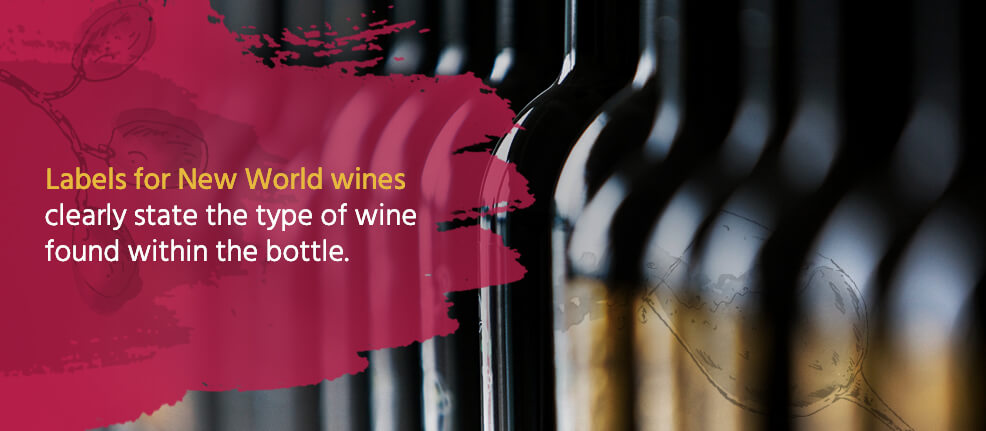
Labels for New World wines clearly state the type of wine found within the bottle. This makes it easier for novice wine drinkers to quickly find and identify their favorite varietals.
Exceptions to Wine Names
Bottles for wine blends typically state red, white or rosé. When a wine doesn’t contain at least 75% of one grape variety, the variety goes unlisted. This explains nondescript labels like “sweet red” or “table white.”
Some winemakers go for puns or spins on common names and phrases, while others tribute favorite celebrities. How about sipping a glass of Marilyn Merlot? Mommy’s Time Out is another wine that makes for a humorous gift for the busy mom.
Wine names can take a personal note for some. Musician Sting, lead singer of The Police, owns a vineyard in Il Palagio, Italy. He names his wines after songs like Message in a Bottle. For Francis Ford Coppola, the award-winning director, his Sofia wines are named after his daughter Sofia.
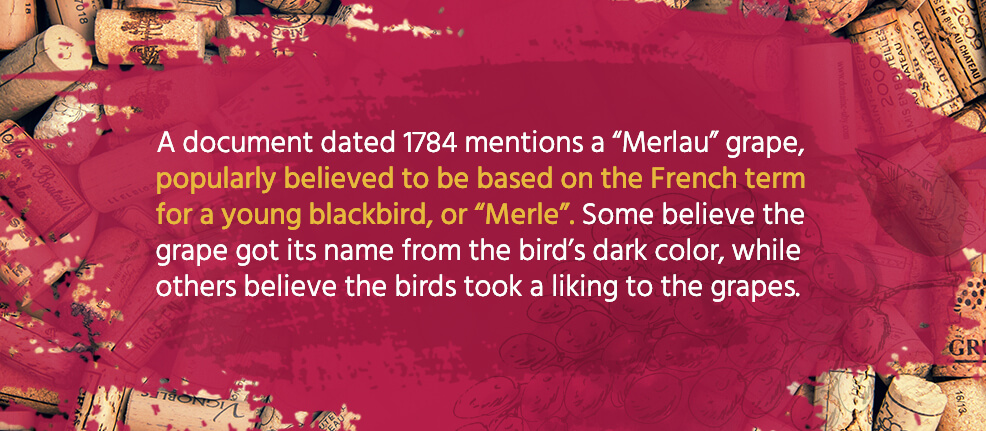
Unique History of Some Wine Names
Some believe chardonnay grapes originally gained their name from an area in Jerusalem. In 2012, the co-founder of Gvaot Winery told a tour group that chardonnay grapes came from Israel. The belief is the name came from the Hebrew phrase “sha’har adonai,” which means “gate of God.” Over time, names for this variety of grapes have changed. Chaudenet, chardonnet and chardennet are just a few examples. There’s also a village in France called Chardonnay.
Merlot also has a fun story regarding its name. This grape variety dates back to 1784. A document dated with 1784 mentions a “merlau” grape, popularly believed to be based on the French term for a young blackbird, or “merle.” Some believe the grape got its name from the bird’s dark color, while others believe the birds took a liking to the grapes.
Ice wine, a sweeter dessert wine, did not get its name from a type of grape or specific region. Despite popular belief, ice wine does not originate in Iceland. The name is based on how the wine is created. It involves a process that occurs when vineyards hold off harvesting grapes until after freezing weather sets in, where workers harvest then the frozen grapes from the vine. These frozen grapes ferment into a very sweet dessert wine with pronounced fruit flavors.
The malbec grape has experienced several name and country changes over the years. It initially earned its place as one of the five key grapes of the Bordeaux region in France and was known as “pressac.” When Sir Malbec transported the grape vines to Medoc, they thrived.
To honor Malbek, the name of pressac grapes changed to malbec. The malbec grape’s popularity declined in France. However, Michel Pouget was responsible for bringing vines on a journey to Argentina. With Argentina’s dry, hot climate, the grapes flourished, developing fruity and spicy notes we associate with a traditional Argentinian Malbec Wine. Malbec grapes are still grown in France but offer a distinct flavor and are frequently used in blends.
Main Categories of Wine
Now that you understand the different names of wine, how do you pick your favorites? Don’t let shopping for a wine overwhelm you. Along with knowing how wines are named, you can also discover the differences between the various types. These categories span regions and grape varieties to create broader wine options. The types of wines created throughout the world fall into one of five main categories:
- Dessert: Dessert wine breaks down into five categories itself — dried grape, fortified, ice, late harvest and noble rot. The sugar content in grapes increases as the grapes age. As a result, you get incredibly sweet wines. As the category’s name implies, dessert wines pair best with the end of your meal, but you don’t have to eat a sugary sweet dessert. Many wines in this category complement fruits and cheeses well.
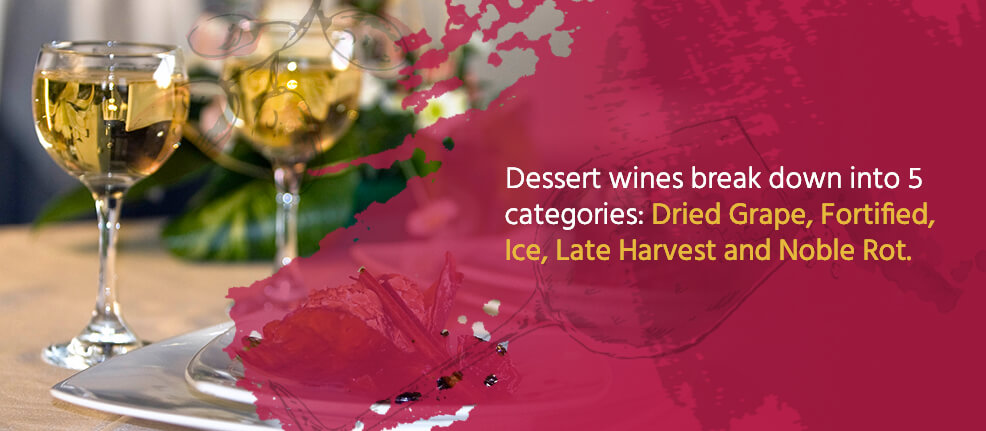
- Red: Red wines get their color from dark purple, red and black grapes. The skin, in particular, gives color to the wine. The winemaking process for reds involves soaking the grape skins in the wines, giving many varietals the characteristic color and tannin content, which creates a dry mouthfeel. A longer soaking time typically creates a drier wine, but you can find sweet reds.
- Rose: Rosé earns its pinkish tone from the grape skin. Workers remove the skin in a shorter amount of time to keep the red coloring to a minimum. That shorter soaking time also creates rosé wines that aren’t as dry, making a suitable wine for red and white wine drinkers alike.
- White: Green grapes or red grapes without the skin create a range of white wines. The lack of red pigmentation limits these wines to a yellow or golden color. And without grape skins, seeds or stems soaking in the wine, many varietals have a lighter body and lower tannin content. The results are refreshing white wines.
- Sparkling: Sparkling wine and Champagne gain their bubbles through a second fermentation stage. During this stage, yeast eats sugar found in the wine to create the carbonation. With their refreshing mouthfeel and flavors, sparkling wines are great to enjoy on their own or as a pairing with salty foods.
These five main categories branch into subcategories. Just as you’re familiar with the five main categories of wine, you’ll probably recognize the subsets you can find across reds, whites and everything between. The subcategories break down wines by sweetness level:
- Dry wines: These occur when fermentation removes all sugars from the grapes. These wines can also have a high tannin content, which contributes to the drying mouthfeel.
- Semi-sweet: These wines occur when fermentation removes most sugars from the grapes. The result is an accessible wine for novice drinkers who want to work their way to dry wines.
- Sweet wines: These occur when fermentation removes very little of the sugars from the grapes. Novice drinkers are likely familiar with sweeter wines.
From there, different wines have various notes. Some wines may have herbal or grassy notes, while others showcase a clear fruitiness with berry notes. Wines may also be earthy with flavors that contrast fruity notes. From time to time, you’ll find wines that don’t fit these categories. Fruit wines made without grapes, like plum, strawberry and rhubarb wines, are good examples.
How to Find and Pick Out Wine by Name
When you find a wine you enjoy, note the varietal. Look up the grapes used and pinpoint the region. With this information, you’ll be able to shop for Old World and New World wines with ease.
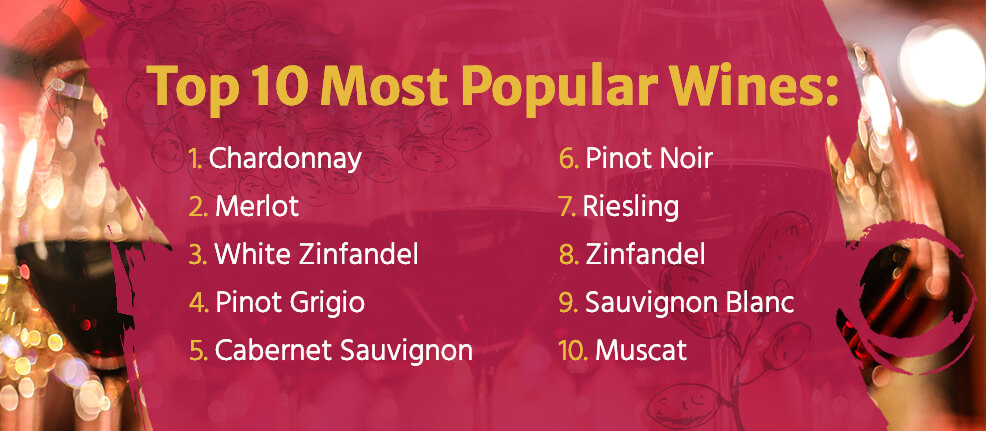
Looking for a popular varietal to try? Whether you’re a wine novice or are looking to branch out, consider what others are drinking. The Wine Market Council came up with a list of favorite wine varietals based on a survey of 1,072 wine drinkers. Participants came from all 50 states in the U.S. The top 10 most popular wines according to the survey are:
- Chardonnay
- Merlot
- White zinfandel
- Pinot grigio
- Cabernet sauvignon
- Pinot noir
- Riesling
- Zinfandel
- Sauvignon blanc
- Muscat
In that same poll, 58% of the respondents say they prefer fruity wines. Semi-sweet followed closely with 57%. Dry wines only appealed to 26%. In addition, the Wine Market Council asked participants to list the top reasons for deciding which wine to buy. The top five answers were:
- Price of the wine (72%)
- Brand (67%)
- Varietal (36%)
- Country the wine’s made in (35%)
- Label design and information (24%)
Of course, feel free to enjoy your favorite wines for any reason. And when you’re running low, stock up with Marketview Liquor. At Marketview Liquor, we’re here to help you navigate all of your wine options. We feature wines from around the world as well as a huge selection of New York wines.
We make it easy for you to buy wine online at great prices and have it shipped directly to your door. Save money on wine while trying various options with select mix and match case discounts and free shipping on select bottles when buying six or more. Need suggestions for an upcoming dinner party or event? Just ask! Our employees will help you find your favorites whether you order for in-store pickup at our Rochester, New York, store or buy online for wine shipped to you.
